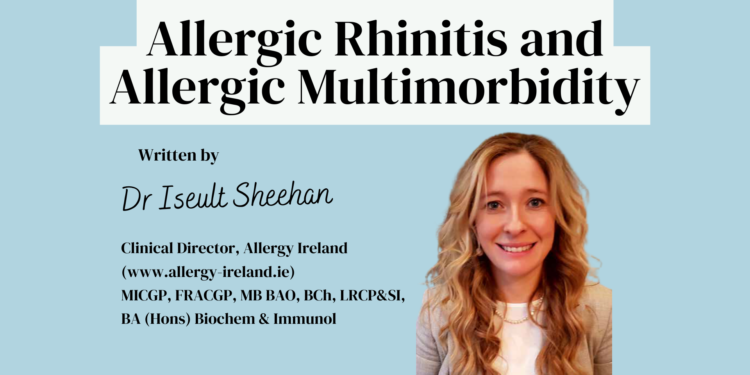Written by Dr Iseult Sheehan Clinical Director, Allergy Ireland (www.allergy-ireland.ie)MICGP, FRACGP, MB BAO, BCh, LRCP&SI, BA (Hons) Biochem & Immunol
Allergic Rhinitis (AR) is an IgE mediated inflammatory reaction following exposure to an inhalant allergen such as dust mite or grass pollen which results in inflammation of the nasal lining. The characteristic symptoms include rhinorrhoea, nasal obstruction, sneezing and nasal pruritis. Patients often experience fatigue and a feeling of heaviness in the head or a ‘fuzzy’ head. The appearance of dark rings under the eyes (allergic shiners) are a common feature for those with nasal and/or sinus congestion.
AR is rarely found in isolation and as such these patients will frequently have one or more allergic comorbidity such as asthma, atopic dermatitis or food allergy. In addition, conjunctivitis, sinusitis and otitis media with effusions can co-exist. AR has also been shown to affect cognitive and psychomotor function. Patients describe the impact on sleep as considerably debilitating.
Nevertheless, the symptoms of AR are often considered to be trivial and AR is underdiagnosed and undertreated despite the burden of this disease. While struggling with AR symptoms the ability to participate in social and sporting activities are reduced and underperformance or missed days at work and school are a feature. AR can have a worrying impact on a child’s education.
Epidemiology
AR is a common condition with a global impact. In Ireland, at least 1 in 5 people suffer with AR 1 . It is estimated that AR affects at least 400 million people worldwide and the prevalence within Europe is between 17 and 29% 1 . The UK has a prevalence of 26% 1 and Ireland is likely to be similar to this. The economic impact is striking. The European Union has recently estimated that the indirect cost of undertreated AR on work productivity may cost between €30 and €50 billion per year 2 .
AR will often begin early in life but prevalence increases with age. The International Study of Asthma and Allergies in Childhood (ISAAC, 2006) phase III study demonstrated this showing a 5% prevalence in those aged 3 years, an 8.5% prevalence in those aged 6-7 years and a 14.6% prevalence in those aged 13-14 years 3 .
What is most concerning is that the prevalence of AR is increasing globally. This was corroborated by this ISAAC study which found an increase in prevalence of AR from 13% to 19% over an 8 year period in a cohort of 13-14yr olds 3 . A smaller study in Cork demonstrated an increase in prevalence from 7.6% to 10.6% over a 5 year period in a cohort of 6-9yr olds 4 .
Pathophysiology
Primary sensitization occurs when an atopic individual is first exposed to an allergen resulting in the differentiation of Th2 helper cells and an environment rich in IL-4, IL-13 and IL-5 cytokines determines the Th2 immune response. T cell dependent activation of B cells stimulates further cytokine production particularly IL-4 and promotes irreversible immunoglobulin class switching to allergen specific IgE antibodies. Allergen specific IgE will attach to mast cells and basophils.
On re-exposure to the allergen the sensitised mast cells degranulate releasing pre-stored and newly synthesised inflammatory mediators such as histamine, leukotrienes and prostaglandins. These contribute to vascular permeability, eosinophil infiltration and increased mucus production.
Furthermore, with repetitive allergen exposure nasal priming occurs. This appears to cause an accumulation of effector cells in the nasal mucosa and results in a hyper-responsiveness to the allergen and prolongation of symptoms. In addition, there appears to be a neural component to this hyper-responsiveness. Changes to the sensory nerves of the nose have been demonstrated in those with AR.
Diagnosis of Allergic Rhinitis
The diagnosis of AR is generally based on clinical symptoms. However skin prick allergy testing or specific IgE blood testing can be used to confirm the allergen trigger.
In addition, it is vital to examine the nose whereby you will often see bulky oedematous turbinates with visible increased mucus production. Pallor of the mucosal lining is often present, particularly in longstanding cases. Occasionally the mucosa will lose its smooth appearance and instead will have ridges and pitting from chronic allergic challenge. Pre-polypoid tissue can occasionally be present.
Multimorbid AR 6Multimorbid AR can be subdivided into:
– Co-morbid allergic diseases such as asthma, atopic dermatitis and food allergy.
– Co-morbid disorders anatomically related to the nose such as conjunctivitis, sinusitis and otitis media.
– Co-morbid disorder of sleep with resultant impact on behaviour.
Asthma
Ireland has the 4th highest prevalence of asthma globally with at least 10% of the population having asthma. AR is a risk factor for asthma. In fact 90% of asthmatics have AR and 30-40% of those with AR have asthma 7 . Poor asthma control has been shown in those with co-existing rhinitis.
A ‘united airways’ disease approach to management is the more favoured approach in recent years. Moreover, the treatment of nasal inflammation in asthmatics has been shown to improve outcomes. This highlights the importance of assessing for both asthma and rhinitis in these patients.
Atopic Dermatitis
The role of allergy in atopic dermatitis (AD) is complex. AD is a chronic inflammatory condition of the skin with the hallmark feature of skin barrier dysfunction further worsened by inflammation and scratching.
A more permeable skin barrier results in transepidermal water loss but it is likely that this also acts as a potential portal for developing allergen sensitisation and thus allergic disease. Indeed, AD is frequently the initial manifestation of atopy and allergic disease.
The genetic predisposition to having a dysfunctional skin barrier and a dysregulated Th2 immune response in AD create the perfect environment for allergen sensitisation.
The initial presentation of early onset AD appears to be in the absence of IgE-mediated allergen sensitisation. However, within a short period of time, sensitisation occurs with elevation of total IgE alongside specific IgE antibodies to environmental allergens such as house dust mite, pollens and animal dander. In fact, it has been shown that approximately 80% of those with AD have specific IgE sensitisation to at least one environment allergen. Despite this, the IgE sensitisation does not necessarily correlate with the development of an allergy or allergic disease.
Nevertheless, children with AD before age 4 years have been found to be twice as likely to develop asthma in later childhood. Indeed 30-50% of children with AD will proceed to developing asthma while 35% will develop allergic rhinitis8. There is also a strong association between having AD and having a co-morbid food allergy which may be as high as 90%.
Food Allergy and Pollen Food Syndrome
In Ireland approximately 3% of the population have a primary food allergy such as a nut or fish allergy. There is an association with allergic rhinitis but the more frequent association is with a secondary food allergy referred to as Pollen Food Syndrome (PFS). PFS refers to a cross-reaction between allergens found in grass, tree or weed pollen and raw fruit, vegetables and some nuts. A study in the UK of 110 adults with AR and pollen sensitization identified 47% of these individuals as having PFS 9 .
These patients will experience hay fever symptoms but can also develop oral symptoms on eating certain raw foods depending on their allergen sensitization (see Table). The symptoms are usually limited to the mouth and throat and are mild including pruritis and mild oedema to lips, tongue, soft palate and occasionally the throat. Individuals can usually tolerate these fruit and vegetables in cooked or processed form. It rarely affects young children and often first appears in teenagers and young adults.
The symptoms often resolve spontaneously within an hour and patients infrequently require adrenaline autoinjectors. Antihistamines are usually sufficient at managing symptoms when required. Sub-lingual Immunotherapy (SLIT) to tree or grass pollen can be effective at desensitisation with minimal adverse effects to alleviate PFS and hay fever symptoms.
Management of AR
It is paramount that these individuals are managed correctly not only to reduce rhinitis symptoms but to improve the comorbid conditions.
Non-Pharmacological Management
Allergen avoidance should be discussed. Nevertheless avoidance alone is generally not sufficient to manage symptoms. In cases where the allergen trigger is animal dander avoidance is effective if the animal is removed from the home.
Smoking cessation should be advised always. Smoking can be associated with chronic nasal symptoms and may even be associated with the development of polyposis. Passive smoking or ‘vaping’ appear to carry similar risk.
Saline irrigation is an effective way to directly cleanse the nasal cavity with the resultant reduction of mucus, inflammatory mediators and bacterial burden. It has also been shown to improve mucociliary function.
Pharmacological Management
A new classification system focusing on the functional ability of the patient, including the frequency and severity of symptoms, has become a much more effective tool for making treatment decisions. This was developed by Allergic 7 Rhinitis and the Impact on Asthma (ARIA) guideline in collaboration with the World Health Organization 7 .
In patients with mild intermittent symptoms an antihistamine is often effective. Second generation antihistamines are recommended as they carry less cholinergic and sedating side effects. Oral or nasal decongestants can be used as a rescue medication but for no longer than 5 days to avoid rebound symptoms.
The ARIA guideline recommends intranasal corticosteroids as the first line treatment for moderate-severe intermittent or persistent AR 7 . A low bioavailability is recommended and so newer generation intranasal corticosteroids are preferred.
If the nasal cavity is very obstructed a nasal spray may not be effective until the oedema has been reduced using intranasal corticosteroid drops. If this is ineffective then a combination intranasal treatment is now available combining corticosteroid and antihistamine.
Eye symptoms can be managed conservatively with cold compresses and tear supplements. However, if these symptoms persist, it is advisable to consider oral and topical antihistamines, topical mast cell stabilizers (sodium cromoglicate) or decongestants. Topical corticosteroids should ideally be prescribed under the care of an Ophthalmologist.
If there is evidence of lower airway irritability or asthma, a leukotriene receptor antagonist can be trialed. In severe cases short courses of oral corticosteroids are occasionally required.
Newer Treatment Options: Immunotherapy
Immunotherapy has been shown to significantly reduce symptoms and medication requirements and is recommended by the ARIA guideline. Additionally, the Global Initiative for Asthma (GINA) 2020 guideline recommends immunotherapy can be considered for asthmatics sensitised to dust mite 11 . Immunotherapy involves exposing a patient to minute quantities of the allergen trigger allowing the immune system to build up a tolerance. It can be given as a subcutaneous injection or as a sublingual tablet. Sublingual therapy is used predominantly in Ireland and is currently available for grass pollen, dust mite and tree pollen. Compliance is crucial and regular follow up advised. It is usually a three year process whereby the patient takes it daily. It is highly effective and well tolerated.
Newer Treatment Options: Endonasal Phototherapy
Phototherapy is well established for skin conditions and is now being used within the nasal cavity to manage AR. It uses UV-A (25%), UV-B (< 5%) and visible light (70%) to induce a local immunosuppressive effect by inhibiting allergen induced histamine release from mast cells and inducing apoptosis of T lymphocytes and Eosinophils. It essentially desensitises the nasal cavity thus reducing symptoms. It is particularly useful when pharmacological treatment is insufficient or contraindicated.
References available on request
Read the full magazine: September IPN
Read our Latest News












